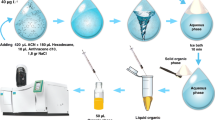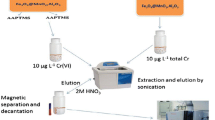Abstract
Magnetic solid-phase extraction combined with GC–MS was applied to monitor phenols in river waters and bottom sediments. Annual and seasonal fluctuations in the phenol level, including their dependence on the flood pattern, rate of snowmelt, fallout of precipitation, and water and air temperature, were interpreted. The distribution of phenol concentrations in storage waters and bottom sediments was determined. A magnetic sorbent based on Fe3O4 nanoparticles and hypercrosslinked polystyrene is proposed for sorption of phenolic pollutants from aqueous media. The achieved enrichment factor (EF = 368–394) allows one to determine chloro- and nitrophenols, guaiacol, and phenol by GC–MS without preliminary derivatization. The limits of detection of phenols in real objects were 1.0–3.1 ng L–1. The developed method was applied to monitor waters and bottom sediments of the Voronezh Reservoir (Voronezh, Russia). Monitoring was performed from November 2015 till May 2019. Phenol, guaiacol, 2-chlorophenol, 3-chlorophenol, 4-chlorophenol, 2,4-dichlorophenol, 2,5-dichlorophenol, 2,4,5-trichlorophenol, and 2,4,6-trichlorophenol, as well as trace amounts of tetrachlorophenols and pentachlorophenol were found to be present in storage waters and bottom sediments. The maps of phenols distribution in the water reservoir at the time of their highest content in waters and bottom sediments were plotted. The highest concentrations of phenols in the reservoir were found to be at the time of extensive spring snowmelt and flood and storm rainfall. The maximum phenol concentrations in waters varied from 7 (for 2,5-dichlorophenol) to 232 ng L–1 (for 2,4-dichlorophenol), while those in bottom sediments were by 30–50% higher.





Similar content being viewed by others
Availability of data and material
All data generated or analyzed during this study are included in this published article and its supplementary information files.
References
Ahmed Adam OE, Al-Dujaili AH (2013) The removal of phenol and its derivatives from aqueous solutions by adsorption on petroleum asphaltene. J Chem 2013:1–8. https://doi.org/10.1155/2013/694029(InChinese)
Alves MN, Miró M, Breadmore MC, Macka M (2019) Trends in analytical separations of magnetic (nano)particles. TrAC Trends Anal Chem 114:89–97. https://doi.org/10.1016/j.trac.2019.02.026
Amelin VG, Bol’shakov D.S., Andoralov AM, (2018) Screening and determination of pesticides from various classes in natural water without sample preparation by ultra HPLC–high-resolution quadrupole time-of-flight mass spectrometry. J Anal Chem 73(3):257–265. https://doi.org/10.1134/s1061934818030024
Andreev YA, Morozova VE, Chernov’yants MS (2015) Determination of polychlorophenols in bottom sediments by gas chromatography. J Anal Chem 70(10):1277–1281. https://doi.org/10.1134/S1061934815080031
Anku WW, Mamo MA, Govender PP (2017) Phenolic compounds in water: sources, reactivity, toxicity and treatment methods. IntechOpen, London, pр 419–443. https://doi.org/10.5772/66927. https://www.intechopen.com/books/phenolic-compounds-natural-sources-importance-and-applications/phenolic-compounds-in-water-sources-reactivity-toxicity-and-treatment-methodshttps
Cai MQ, Su J, Hu JQ, Wang Q, Dong CY, Pan SD, Jin MC (2016) Planar graphene oxide-based magnetic ionic liquid nanomaterial for extraction of chlorophenols from environmental water samples coupled with liquid chromatography–tandem mass spectrometry. J Chromatogr A 1459:38–46. https://doi.org/10.1016/j.chroma.2016.06.086
Chen J, Sun X, Lin L, Dong X, He Y (2017) Adsorption removal of o-nitrophenol and p-nitrophenol from wastewater by metal–organic framework Cr-BDC. Chin J Chem Eng 25(6):775–781. https://doi.org/10.1016/j.cjche.2016.10.014
Chuvychkin AL, Yablonskikh LA, Devyatova TA (2018) Quality of surface waters of Voronezh reservoir and their influence to population health. Proc Voronezh State Univ Ser Chem Biol Pharm 2:270–277 (in Russian)
Czaplicka M (2006) Photo-degradation of chlorophenols in the aqueous solution. J Hazard Mater 134(1–3):45–59. https://doi.org/10.1016/j.jhazmat.2005.10.039
Dujaković N, Grujić S, Radišić M, Vasiljević T, Laušević M (2010) Determination of pesticides in surface and ground waters by liquid chromatography–electrospray–tandem mass spectrometry. Anal Chim Acta 678(1):63–72. https://doi.org/10.1016/j.aca.2010.08.016
EPA (2014) Priority pollutant list. https://www.epa.gov/sites/production/files/2015-09/documents/priority-pollutant-list-epa.pdf
Eslami A, Hashemi M, Ghanbari F (2018) Degradation of 4-chlorophenol using catalyzed peroxymonosulfate with nano-MnO2/UV irradiation: toxicity assessment and evaluation for industrial wastewater treatment. J Clean Prod 195:1389–1397. https://doi.org/10.1016/j.jclepro.2018.05.137
Fattahi N, Assadi Y, Hosseini MR, Jahromi EZ (2007) Determination of chlorophenols in water samples using simultaneous dispersive liquid–liquid microextraction and derivatization followed by gas chromatography-electron-capture detection. J Chromatogr A 1157(1–2):23–29. https://doi.org/10.1016/j.chroma.2007.04.062
Federal Hydrometeorological Service (2020) Available at: https://www.meteorf.ru/product/climat/. Accessed 15 Apr 2020 (In Russian)
Gao J, Liu L, Liu X, Zhou H, Huang S, Wang Z (2008) Levels and spatial distribution of chlorophenols—2,4-dichlorophenol, 2,4,6-trichlorophenol, and pentachlorophenol in surface water of China. Chemosphere 71(6):1181–1187. https://doi.org/10.1016/j.chemosphere.2007.10.018
Garba ZN, Zhou W, Lawan I, Xiao W, Zhang M, Wang L, Chen L, Yuan Z (2019) An overview of chlorophenols as contaminants and their removal from wastewater by adsorption: a review. J Environ Manag 241:59–75. https://doi.org/10.1016/j.jenvman.2019.04.004
Ge T, Han J, Qi Y, Gu X, Ma L, Zhang C, Naeem S, Huang D (2017) The toxic effects of chlorophenols and associated mechanisms in fish. Aquat Toxicol 184:78–93. https://doi.org/10.1016/j.aquatox.2017.01.005
Giakisikli G, Anthemidis AN (2013) Automated magnetic sorbent extraction based on octadecylsilane functionalized maghemite magnetic particles in a sequential injection system coupled with electrothermal atomic absorption spectrometry for metal determination. Talanta 110:229–235. https://doi.org/10.1016/j.talanta.2013.02.035
GN 2.1.5.1315-03 (Hygienic Regulations) (2020) Maximum permissible concentrations of chemical substances in waters for general and drinking purposes (in Russian)
Gu Q, Wu Q, Zhang J, Guo W, Wu H, Sun M (2016) Community analysis and recovery of phenol-degrading bacteria from drinking water biofilters. Front Microbiol 7:495–505. https://doi.org/10.3389/fmicb.2016.00495
Gubin AS, Sukhanov PT, Kushnir AA, Proskuryakova ED (2018) Recovery and preconcentration of phenols from aqueous solutions with a magnetic sorbent based on Fe3O4 nanoparticles and hyper-cross-linked polystyrene. Russ J Appl Chem 91(10):1626–1634. https://doi.org/10.1134/s1070427218100099
Guseva TV, Zaika EA, Vinichenko VN, Molchanova YP, Averochkin EM (2000) Hydrochemical indicators of environmental state. In: SoES Moscow, p148 (in Russian)
Hlongwane GN, Sekoai PT, Meyyappan M, Moothi K (2018) Simultaneous removal of pollutants from water using nanoparticles: a shift from single pollutant control to multiple pollutant control. Sci Total Environ 656:808–833. https://doi.org/10.1016/j.scitotenv.2018.11.257
Igbinosa EO, Odjadjare EE, Chigor VN, Igbinosa IH, Emoghene AO, Ekhaise FO, Igiehon NO, Idemudia OG (2013) Toxicological profile of chlorophenols and their derivatives in the environment: the public health perspective. Sci World J 2013:1–11. https://doi.org/10.1155/2013/460215
Kameni APW, Tcheumi HL, Tonle IK, Ngameni E (2019) Sensitive electrochemical detection of methyl parathion in the presence of para-nitrophenol on a glassy carbon electrode modified by a functionalized NiAl-layered double hydroxide. C R Chim 22(1):22–33. https://doi.org/10.1016/j.crci.2018.11.001
Kishino T, Kobayashi K (1995) Relation between toxicity and accumulation of chlorophenols at various pH, and their absorption mechanism in fish. Water Res 29(2):431–442. https://doi.org/10.1016/0043-1354(94)00189-e
Kuśmierek K, Szala M, Świątkowski A (2016) Adsorption of 2,4-dichlorophenol and 2,4-dichlorophenoxyacetic acid from aqueous solutions on carbonaceous materials obtained by combustion synthesis. J Taiwan Inst Chem Eng 63:371–378. https://doi.org/10.1016/j.jtice.2016.03.036
Li Y, Wang X, Toms LM, He C, Hobson P, Sly PD, Aylward LL, Mueller JF (2019) Pesticide metabolite concentrations in Queensland pre-schoolers—exposure trends related to age and sex using urinary biomarkers. Environ Res 176:108532. https://doi.org/10.1016/j.envres.2019.108532
Magasumova AT, Khatmullina RM, Safarova VI, Kitaeva IM, Kudasheva FK (2014) Effect of concomitant organic compounds on the value of phenolic index. J Analyt Chem 69(3):237–242. https://doi.org/10.1134/s1061934814030113
Öberg T, Warman K, Bergström J (1989) Production of chlorinated aromatics in the post-combustion zone and boiler. Chemosphere 19(1–6):317–322. https://doi.org/10.1016/0045-6535(89)90330-5
Oikari A, Holmbom B, Ånäs E, Miilunpalo M, Kruzynski G, Castrén M (1985) Ecotoxicological aspects of pulp and paper mill effluents discharged to an inland water system: distribution in water, and toxicant residues and physiological effects in caged fish (Salmo gairdneri). Aquat Toxicol 6(3):219–239. https://doi.org/10.1016/0166-445x(85)90006-2
Order (2016) The Order of Ministry of Agriculture of the Russian Federation (No 552, 13.12.2016) "Approval of water quality standards for water bodies of fishery value including the standards of maximum permissible concentrations of harmful substances in the waters of water bodies of fishery value (as amended on October 12, 2018)" (in Russian)
Pokryshkin SA, Kosyakov DS, Kozhevnikov AY, Lakhmanov DE, Ul’yanovskii NV (2018) Highly sensitive determination of chlorophenols in sea water by gas chromatography−tandem mass spectrometry. J Analyt Chem 73(10):991–998. https://doi.org/10.1134/s1061934818100088
Report (2018) The Annual Report about environmental state in Voronezh Region (2018). https://www.govvrn.ru/novost/-/~/id/4034068 (in Russian)
Resolution (2003) Resolution of the Chief State Sanitary Doctor of the Russian Federation of April 30, 2003 N 78 (as amended on July 13, 2017) "On the entry into force of GN 2.1.5.1315–03" (together with "GN 2.1.5.1315–03. Maximum allowable levels (MPC) of chemical Hygienic standards ", approved by the Chief State Sanitary Doctor of the Russian Federation on 04/27/2003) (Registered in the Ministry of Justice of Russia on 05/19/2003 N 4550) (in Russian)
SanPiN 2.1.4.1074-01 (Sanitary Rules and Regulations) (2020) Drinking water. Hygienic requirements for water quality. Quality control. Hygienic requirements for hot water systems safety (in Russian)
Siddiqui MTH, Nizamuddin S, Baloch HA, Mubarak NM, Al-Ali M, Mazari SA, Bhutto AW, Abro R, Srinivasan M, Griffin G (2018) Fabrication of advance magnetic carbon nano-materials and their potential applications: a review. J Environ Chem Eng 7(1):102812. https://doi.org/10.1016/j.jece.2018.102812
Sousa JCG, Ribeiro AR, Barbosa MO, Pereira MFR, Silva AMT (2018) A review on environmental monitoring of water organic pollutants identified by EU guidelines. J Hazard Mater 344:146–162. https://doi.org/10.1016/j.jhazmat.2017.09.058
Tan P, Jiang Y, Liu X, Sun L (2019) Magnetic-responsive porous materials for efficient adsorption and desorption processes. Chin J Chem Eng 27(6):1324–1338. https://doi.org/10.1016/j.cjche.2018.11.004
Tang S, Sun J, Xia D, Zang B, Gao Y, Chen C, Shen W, Lee HK (2018) In-syringe extraction using compressible and self-recoverable, amphiphilic graphene aerogel as sorbent for determination of phenols. Talanta 195:165–172. https://doi.org/10.1016/j.talanta.2018.11.038
Taylor P, Dellinger B (1999) Pyrolysis and molecular growth of chlorinated hydrocarbons. J Anal Appl Pyrolysis 49(1–2):9–29. https://doi.org/10.1016/s0165-2370(98)00098-9
Tong L, Guo L, Lv X, Li Y (2017) Modification of polychlorinated phenols and evaluation of their toxicity, biodegradation and bioconcentration using three-dimensional quantitative structure–activity relationship models. J Mol Gr Model 71:1–12. https://doi.org/10.1016/j.jmgm.2016.10.012
Villegas LG, Mashhadi N, Chen M, Mukherjee D, Taylor KE, Biswas N (2016) A short review of techniques for phenol removal from wastewater. Curr Pollut Rep 2(3):157–167. https://doi.org/10.1007/s40726-016-0035-3
Wang X, Wang H, Huang P, Ma X, Lu X, Du X (2017) Preparation of three-dimensional mesoporous polymer in situ polymerization solid phase microextraction fiber and its application to the determination of seven chlorophenols. J Chromatogr A 1479:40–47. https://doi.org/10.1016/j.chroma.2016.12.010
Water of Russia (2020) Water of Russia. Voronezh reservoir. Available at: https://water-rf.ru/. Accessed 15 Apr 2020 (In Russian)
Weather Archive (2020) Weather archive in Voronezh. Available at: https://rp5.ru/Weather_archive_in_Voronezh. Accessed 15 Apr 2020
Wu H, Li G, Liu S, Hu N, Geng D, Chen G, Sun Z, Zhao X, You J (2016) Monitoring the contents of six steroidal and phenolic endocrine disrupting chemicals in chicken, fish and aquaculture pond water samples using pre-column derivatization and dispersive liquid–liquid microextraction with the aid of experimental design methodology. Food Chem 192:98–106. https://doi.org/10.1016/j.foodchem.2015.06.059
Xu X, Liu Z, Zhang X, Duan S, Xu S, Zhou C (2011) β-Cyclodextrin functionalized mesoporous silica for electrochemical selective sensor: simultaneous determination of nitrophenol isomers. Electrochim Acta 58:142–149. https://doi.org/10.1016/j.electacta.2011.09.015
Yang H, Lu F, Sun Y, Yuan Z, Lu C (2018) Fluorescent gold nanocluster-based sensor array for nitrophenol isomer discrimination via an integration of host-guest interaction and Inner Filter Effect. Anal Chem 90(21):12846–12853. https://doi.org/10.1021/acs.analchem.8b03394
Zamora-Garcia IR, Alatorre-Ordaz A, Ibanez JG, Torres-Elguera JC, Wrobel K, Gutierrez-Granados S (2017) Degradation of pentachlorophenol as a model hazardous and recalcitrant organochlorinated pollutant using AgIII. Environ Chem 14(8):476. https://doi.org/10.1071/en17114
Zhang H, Zhu Y, Chen L, Zhao J (2008) Sorption of phenolic compounds by suspended particulates. Environ Sci 29(1):71–76
Zhang Z, Zhou J, Liu Y, Tang J, Tang W (2015) Cyclodextrin capped CdTe quantum dots as versatile fluorescence sensors for nitrophenol isomers. Nanoscale 7(46):19540–19546. https://doi.org/10.1039/c5nr06073g
Zhang J, Cui S, Ding Y, Yang X, Guo K, Zhao JT (2018) Two-dimensional mesoporous ZnCo2O4 nanosheets as a novel electrocatalyst for detection of o-nitrophenol and p-nitrophenol. Biosens Bioelectron 112:177–185. https://doi.org/10.1016/j.bios.2018.03.021
Funding
The funding organizations had no role in the design of the study, and collection, analysis, and interpretation of the data, or writing of the manuscript.
Author information
Authors and Affiliations
Corresponding author
Ethics declarations
Conflict of interest
The authors state that they have no conflicts of interest regarding this work.
Additional information
Publisher's Note
Springer Nature remains neutral with regard to jurisdictional claims in published maps and institutional affiliations.
Electronic supplementary material
Below is the link to the electronic supplementary material.
Rights and permissions
About this article
Cite this article
Gubin, A., Sukhanov, P., Kushnir, A. et al. Monitoring of phenols in natural waters and bottom sediments: preconcentration on a magnetic sorbent, GC–MS analysis, and weather observations. Chem. Pap. 75, 1445–1456 (2021). https://doi.org/10.1007/s11696-020-01398-6
Received:
Accepted:
Published:
Issue Date:
DOI: https://doi.org/10.1007/s11696-020-01398-6




